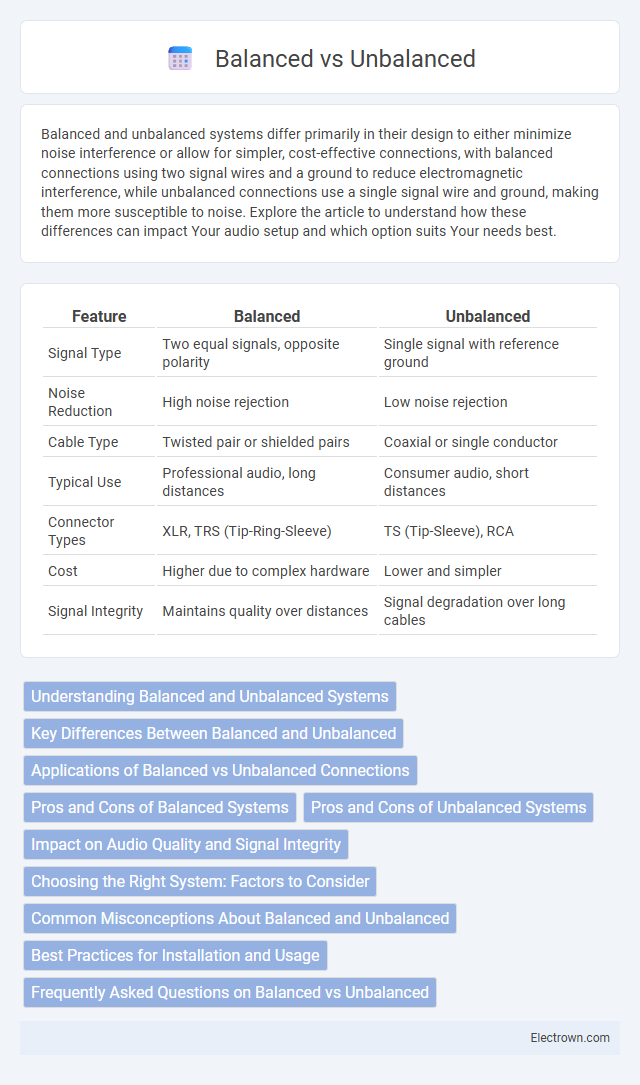Balanced and unbalanced systems differ primarily in their design to either minimize noise interference or allow for simpler, cost-effective connections, with balanced connections using two signal wires and a ground to reduce electromagnetic interference, while unbalanced connections use a single signal wire and ground, making them more susceptible to noise. Explore the article to understand how these differences can impact Your audio setup and which option suits Your needs best.
Table of Comparison
| Feature | Balanced | Unbalanced |
|---|---|---|
| Signal Type | Two equal signals, opposite polarity | Single signal with reference ground |
| Noise Reduction | High noise rejection | Low noise rejection |
| Cable Type | Twisted pair or shielded pairs | Coaxial or single conductor |
| Typical Use | Professional audio, long distances | Consumer audio, short distances |
| Connector Types | XLR, TRS (Tip-Ring-Sleeve) | TS (Tip-Sleeve), RCA |
| Cost | Higher due to complex hardware | Lower and simpler |
| Signal Integrity | Maintains quality over distances | Signal degradation over long cables |
Understanding Balanced and Unbalanced Systems
Balanced systems distribute power or signals evenly across all components, minimizing interference and ensuring optimal performance in electrical, audio, and data transmission contexts. Unbalanced systems use a single conductor and ground reference, making them more susceptible to noise and signal degradation, especially over long distances. Understanding the differences between balanced and unbalanced configurations is crucial for selecting the appropriate system to maintain signal integrity and reduce electromagnetic interference.
Key Differences Between Balanced and Unbalanced
Balanced connections use two signal wires and a ground to minimize noise and interference, making them ideal for professional audio and long cable runs. Unbalanced connections rely on a single signal wire and ground, which makes them more susceptible to noise, suitable for short distances and consumer equipment. Your choice between balanced and unbalanced depends on your need for noise rejection and cable length requirements.
Applications of Balanced vs Unbalanced Connections
Balanced connections are widely used in professional audio, broadcast, and recording studios due to their superior noise rejection and signal integrity over long cable runs, making them ideal for microphones and high-quality audio equipment. Unbalanced connections are commonly found in consumer electronics, such as guitars, home audio systems, and short-distance patch cables, where cost efficiency and simplicity take precedence over noise immunity. Understanding the specific application requirements helps determine the appropriate connection type to ensure optimal audio performance and reliability.
Pros and Cons of Balanced Systems
Balanced audio systems offer superior noise rejection and reduced interference, making them ideal for professional and high-fidelity audio environments. Their design minimizes signal degradation over long cable runs, preserving sound quality and providing a consistent listening experience. However, balanced systems tend to be more complex and costly compared to unbalanced setups, which might not be necessary for casual or short-distance audio applications.
Pros and Cons of Unbalanced Systems
Unbalanced systems offer simplicity and cost savings by using fewer components and less wiring, making them ideal for short-distance or consumer audio applications. However, they are more susceptible to noise and interference, which can degrade signal quality in professional or long-distance setups. The lack of noise rejection limits their effectiveness in environments with electrical interference or where high fidelity is crucial.
Impact on Audio Quality and Signal Integrity
Balanced audio connections use two signal wires and a ground, effectively reducing electromagnetic interference and maintaining superior signal integrity for clearer, noise-free sound. Unbalanced connections, relying on a single signal wire and ground, are more susceptible to noise and signal degradation, especially over longer cable runs. Your audio setup benefits from balanced cables by preserving high-fidelity sound and minimizing hum or buzz, ensuring optimal audio quality.
Choosing the Right System: Factors to Consider
Choosing the right audio system involves understanding the benefits of balanced versus unbalanced connections. Balanced systems offer superior noise reduction and signal integrity, especially for longer cable runs or professional environments, while unbalanced systems are typically simpler and more cost-effective for shorter distances. Consider your audio setup's size, environment, and performance needs to ensure your system delivers optimal sound quality without interference.
Common Misconceptions About Balanced and Unbalanced
Common misconceptions about balanced and unbalanced audio connections include the belief that balanced cables are always superior regardless of the setup, or that unbalanced cables cannot provide high-quality sound. Balanced connections effectively reduce noise and interference over long distances by using differential signaling, which unbalanced cables lack. Understanding your specific audio environment and equipment helps you choose the right cable type to ensure optimal sound performance.
Best Practices for Installation and Usage
Balanced cables minimize noise and interference by using two signal wires and a ground, making them ideal for professional audio setups. Unbalanced cables, typically consisting of a single signal wire and ground, are more susceptible to noise but simpler and cost-effective for short-distance connections. For optimal performance, ensure balanced cable installations maintain proper grounding and twisted pair wiring, while unbalanced connections should be kept short and away from electromagnetic interference to protect Your audio quality.
Frequently Asked Questions on Balanced vs Unbalanced
Balanced and unbalanced connections differ primarily in noise reduction and signal integrity. Balanced cables, such as XLR or TRS, use two conductors and a ground to cancel out electromagnetic interference, making them ideal for long cable runs. Your choice between balanced and unbalanced depends on the equipment and environment, with unbalanced cables typically used for shorter distances and simpler setups where noise interference is minimal.
balanced vs unbalanced Infographic

 electrown.com
electrown.com